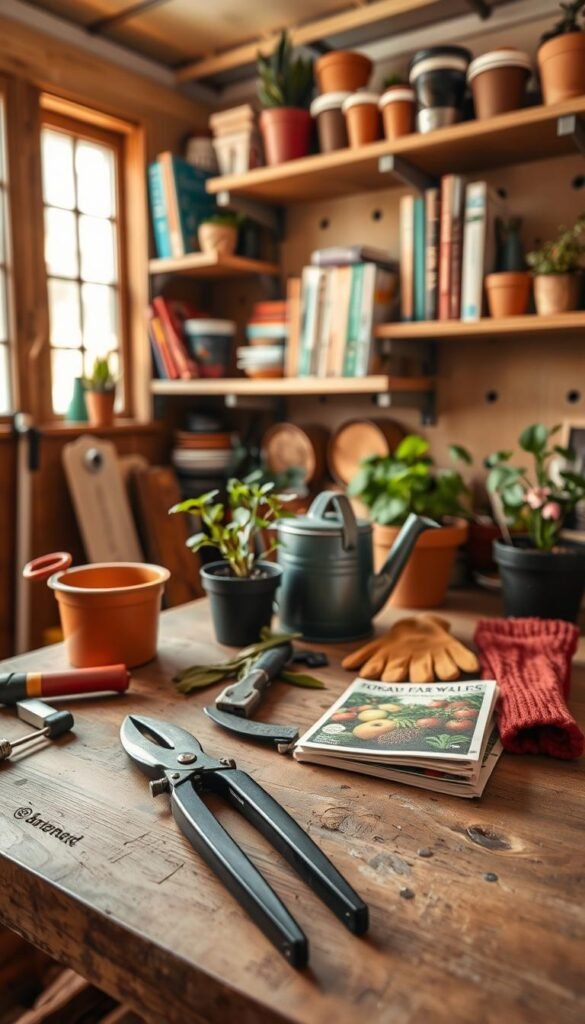Growing your own plants brings fresh flavors to your table and peace to your mind. Whether you want crisp vegetables or vibrant flowers, a small space is all you need to begin. A 10×10-foot plot or a 4×4-foot raised bed works perfectly for new growers.
This guide simplifies the process with a clear checklist. You’ll learn how to pick the right seeds, prepare soil, and time your planting for each season. Tools like the Old Farmer’s Almanac Garden Planner help organize your work.
By following these steps, you’ll gain confidence and enjoy homegrown rewards. Let’s dig into the basics—one easy task at a time.
Why Start a Garden? Fresh Food and Fun Await!

Nothing beats biting into a sun-warmed tomato picked straight from your backyard. Homegrown vegetables burst with flavor, thanks to ripe-until-picked nutrients store-bought produce often lacks. A single vine can save you $50 a year on salads and sauces.
The Joys of Homegrown Vegetables
Compare grocery tomatoes—picked green and shipped miles—to juicy, garden-ripened ones. Your plants offer richer taste, brighter colors, and zero pesticides. Herbs like basil thrive with minimal care, turning a $4 grocery bunch into a year-round supply.
Gardening as a Rewarding Hobby
Spending time outdoors with your hands in the soil lowers cortisol levels. Studies show soil microbes boost serotonin, making weeding as calming as yoga. Plus, 30 minutes of digging burns 150 calories—like a brisk walk.
Kids love watching seeds sprout leaves and roots, turning science lessons into snacks. Your garden becomes a sanctuary, where every watering can or harvest basket adds joy to daily routines.
Pick the Perfect Spot for Your Garden
Location matters—pick wisely to set your plants up for success. The right spot balances sunlight, soil quality, and protection from harsh winds. Here’s how to find it.
Sunlight: The 6-Hour Rule
Most veggies and flowers need 6–8 hours of direct sun daily. Use the shadow tracking method:
- Place sticks in potential garden areas at sunrise.
- Mark shadow edges every 2 hours.
- Count full sun periods (unshaded).
Avoid spots near tall trees or buildings that block light.
Test Your Soil Like a Pro
Healthy soil drains well and suits your plants. Try this simple check:
- Dig a 12-inch hole, fill it with water.
- Time how long it takes to drain. Ideal: 1–3 hours.
For clay soil, build raised beds or mix in compost. Test pH with a $10 kit—most veggies thrive at 6.0–7.0.
Shield Against Wind and Frost
Strong winds dry out soil and snap stems. Protect your garden with:
- Lattice panels (temporary).
- Shrub borders (long-term).
- Burlap screens (winter).
Watch for microclimates—low spots frost earlier. Avoid planting near walnut trees (roots harm tomatoes).
Pro tip: Call 811 before digging to check for underground utilities. Your perfect spot is out there!
Start Small: Choosing the Right Garden Size

Big dreams don’t need big spaces. A compact garden saves time, money, and effort while still delivering fresh veggies and blooms. Focus on what fits your lifestyle—whether it’s a few containers on a balcony or a modest plot.
Smart Sizes for New Growers
Beginners thrive with manageable spaces. Here’s a quick list to match your commitment level:
- 4×4-foot raised beds: Ideal for patios. Needs just 15 minutes of daily care.
- 10×10-foot in-ground plots: Requires 45 minutes daily but fits more plants.
- Container gardens: Perfect for herbs or cherry tomatoes. Start with 3–5 pots.
Example: A 4×4 bed holds 16 plants—like 4 lettuces, 2 peppers, and 10 radishes. Avoid space-hungry crops like corn or pumpkins.
Raised Beds vs. In-Ground: Key Differences
Each option has pros and cons. Compare them below:
| Feature | Raised Beds | In-Ground |
|---|---|---|
| Cost | $25 for soil | $120+ for tiller rental |
| Maintenance | Less weeding | More watering |
| Accessibility | Easier on knees | Needs bending |
Make sure to use ergonomic tools like angled trowels for raised beds. For patios, try vertical planters to maximize space.
Succession planting keeps small gardens productive. After harvesting spinach, plant bush beans in the same spot. BHG recommends starting with just a few plants to gauge your capacity.
Gardening for Beginners: The Ultimate Starter Checklist of Easy Plants

Starting with the right plants sets you up for success. Choose varieties that forgive mistakes and reward effort quickly. This list focuses on fast-growing vegetables and resilient flowers perfect for first-time growers.
Fast-Growing Vegetables for Quick Wins
These crops deliver fast results with minimal fuss. Radishes lead the pack, ready in just 25 days. Lettuce follows close behind—snip leaves as needed after 30 days.
Here’s a comparison of top starter veggies:
| Plant | Days to Harvest | Special Tip |
|---|---|---|
| Radishes | 25 | Plant every 2 weeks for continuous crops |
| Bush Beans | 50 | ‘Blue Lake’ resists bean beetles |
| Cherry Tomatoes | 60 | ‘Sweet 100’ produces hundreds |
| Zucchini | 45 | One plant feeds a family |
For small spaces, try compact varieties like ‘Patio Pride’ peppers. They thrive in containers with just 6 hours of sun.
Flowers That Work Hard in Your Garden
Bright blooms do more than look pretty—they attract pollinators and deter pests. Marigolds release a scent that repels nematodes, especially when planted near tomatoes.
Top no-fail flowers for beginners:
- Nasturtiums – Edible blooms add spice to salads
- Zinnias – Bloom all season with zero deadheading
- Sunflowers – Kids love growing these giants
Pair nasturtiums with squash—their peppery leaves confuse squash bugs. For perennial color, plant daylilies or lavender. Avoid mint unless contained—it spreads aggressively.
Pro tip: Soak parsley seeds overnight to speed up slow germination. Use a heat mat for peppers—they sprout faster in warm soil.
Essential Tools Every Beginner Gardener Needs

The right tools turn garden chores into simple, satisfying tasks. With a few smart picks, you’ll prep soil, fight weeds, and nurture plants without breaking a sweat. Skip the overwhelm—this guide covers only what you’ll use daily.
Must-Have Tools for Planting and Care
Start with these five versatile tools:
- Hori-Hori knife: Digs, cuts roots, and measures planting depth. Stainless steel lasts decades.
- Stirrup hoe: Slices weeds at the roots with a push-pull motion.
- Ergonomic trowel: Easy-grip handle reduces wrist strain when working soil.
- Pruners: Bypass blades (not anvil) make clean cuts on stems up to ¾-inch thick.
- Watering wand: Gentle shower setting prevents soil erosion around seedlings.
Budget-Friendly Alternatives
Save money without sacrificing quality:
| Tool | Premium Option | Budget Swap |
|---|---|---|
| Seed starters | $25 peat pots | Yogurt cups (poked with holes) |
| Soil sieve | $40 mesh screen | Old colander |
| Pest control | $18 spray bottle | Dish soap + water mix |
Make sure to sharpen pruners monthly with a $5 file. For arthritis-friendly care, try foam grip extenders. Skip electric seeders—hand sowing builds connection to your garden.
Like hydroponic systems, traditional gardens thrive with consistent water and pest checks. Store tools indoors to prevent rust, and oil wooden handles yearly.
When to Plant: Understanding Your Growing Season

Your planting schedule makes or breaks your garden’s success. Matching crops to your local season ensures healthy growth and bigger harvests. Start by learning your area’s last frost date—the key to perfect timing.
Cool-Season vs. Warm-Season Crops
Not all plants thrive in the same weather. Cool-season varieties like peas and spinach tolerate chilly spring soil (as low as 45°F). Warm-season stars like tomatoes need 60°F+ soil to avoid stunted growth.
Top picks for each season:
- Cool-season: Lettuce, radishes, kale (plant 4–6 weeks before last frost)
- Warm-season: Beans, cucumbers, peppers (plant 1–2 weeks after frost)
How to Find Your Last Frost Date
Use the Old Farmer’s Almanac tool by entering your zip code. For example:
| USDA Zone | Last Frost | Crop Examples |
|---|---|---|
| 5 (Chicago) | April 20 | Peas, pansies |
| 9 (Phoenix) | February 1 | Tomatoes, snapdragons |
Pro tip: Extend your planting window with row covers. These fabric blankets protect seedlings from light frosts. For flowers, try frost-hardy pansies or calendula—they bloom even after chilly nights.
Nursery plants save time but check labels—big box stores often display warm-season crops too early. Start seeds indoors 6–8 weeks before transplanting for a head start.
Soil Prep 101: Building a Healthy Foundation
Healthy soil is the secret behind thriving plants. It feeds roots, holds water, and fights off weeds. With simple steps, you can transform even poor dirt into a nutrient-rich haven.
Testing and Amending Your Soil
Start with a soil test kit ($10–$20). Results show pH levels and nutrients like nitrogen (N), phosphorus (P), and potassium (K). Ideal ranges:
| Nutrient | Optimal Level | Quick Fix |
|---|---|---|
| Nitrogen | 20–40 ppm | Add composted manure |
| Phosphorus | 30–50 ppm | Bone meal or rock phosphate |
| Potassium | 150–200 ppm | Wood ash (for acidic soil) |
For heavy clay, mix in coarse sand and compost. Sandy soil? Add peat moss to retain water. The Old Farmer’s Almanac recommends testing every 2–3 years.
The Role of Compost and Mulch
Compost boosts nutrients naturally. Try lasagna layering for new beds:
- Cardboard (blocks weeds)
- Green waste (vegetable scraps)
- Brown waste (dry leaves)
- Topsoil (2-inch layer)
Mulch types compared:
- Straw: Best for veggies, decomposes fast
- Wood chips: Long-lasting, ideal for paths
- Leaf mold: Free if you have trees
Make sure to keep mulch 3 inches away from stems to prevent rot. For small spaces, a worm bin turns kitchen scraps into rich compost in weeks.
Daily and Weekly Garden Care Tips
Consistent care keeps your garden thriving with minimal effort. Focus on two pillars: smart watering and proactive weed and pest control. Small daily actions add up to lush leaves and strong roots.
Water Like a Pro
Morning watering cuts evaporation and prevents mold. Use the finger test—poke soil 2 inches deep. If dry, it’s time to hydrate. Here’s how much your plants need:
| Plant Type | Water per Week | Best Method |
|---|---|---|
| Vegetables | 1 inch (62 gallons/100 sq ft) | Soaker hose |
| Flowers | 0.5 inch | Watering wand |
Deep water 2–3 times weekly instead of daily sprinkles. This encourages deeper roots. For pots, lift them—lightweight means thirsty.
Outsmart Weeds and Pests
Pull weeds after rain or watering—they slide out easily. Keep a weed warrior kit:
- Hori-Hori knife for taproots
- Boiling water for sidewalk cracks
- Corn gluten meal (prevents seeds)
For pests, invite allies like ladybugs (eat aphids) or lacewings (target mites). Make a natural spray:
- Blend 2 garlic bulbs + 1 chili pepper
- Steep in 1 quart water overnight
- Strain and spray leaves weekly
Snap photos weekly to track plant health. Yellow leaves? Overwatering. Holes? Check for slugs at dusk.
Your Gardening Journey Starts Here!
Every thriving garden starts with a single seed. Celebrate small wins—like your first sprout or harvest—to stay motivated. Track progress with apps like Gardenize or a simple journal.
Connect with local resources. Extension offices offer free soil tests, and seed swaps introduce you to rare varieties. Join online communities like r/UrbanGardening for real-time advice.
Struggling? Rescue wilted plants with shade and extra water. Overcrowded seedlings? Thin them to one per inch. Mistakes are part of the work.
Plan ahead! In spring, refresh mulch. Summer calls for pest checks. Use our seasonal checklist to stay on track all year.
Now, grab your trowel. Your garden story begins today.






